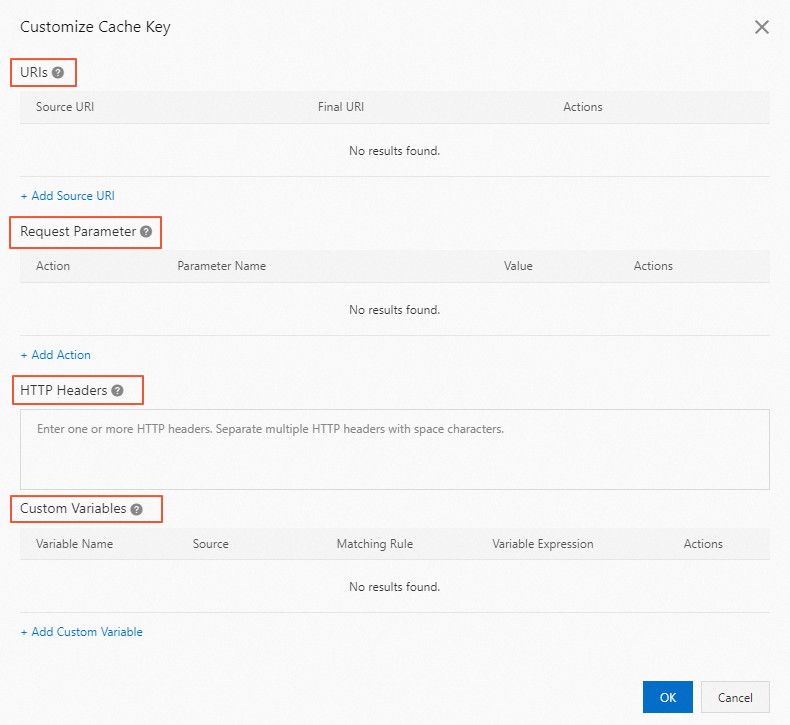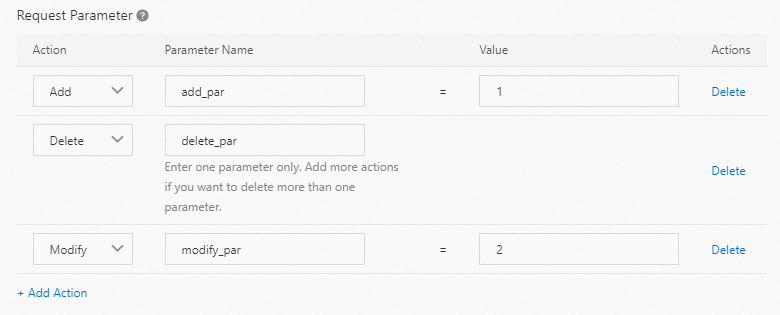A cache key is a unique ID for a file that is cached on a Dynamic Route for CDN (DCDN) node. By default, a cache key is the URL in a request, including the parameters. DCDN allows you to rewrite the cache keys of requests that are destined for the same resource file to the same cache key. This helps you save the cache space and reduce the number of requests redirected to the origin server. This topic describes how to set a custom cache key.
Scenarios
Scenario 1:


Scenario 2:


Procedure
- Log on to the DCDN console.
- On the Domain Names page, find the domain name that you want to manage and click Configure in the Actions column.
- In the left-side navigation pane on the details page of the specified domain name, click Cache.
- On the Custom Cache Key tab, set a cache key. Note
- You can modify only the URIs, parameter actions, and HTTP headers in a cache key. Custom variables are supported. You can add variables to retrieve fields from requests. A cache key consists of URIs, parameter actions, HTTP headers, and custom variables.
- Custom cache keys do not modify the URLs of requests that are redirected to origin servers. Custom cache keys only modify the cache identifiers in these requests. Requests redirected to origin servers and sent by clients carry the same content.

- Click OK.
Example
URIs
http://example.com/a/b/test.jpg and http://example.com/a/b/c/test.jpg are considered requests sent to retrieve the same resource file. The cache key of the resource file is http://example.com/c/test.jpg. 
Parameter Actions
http://example.com/a/b/test.jpg?delete_par=1&modify_par=1. The parameter add_par=1 is added to the URL, the parameter delete_par is deleted from the URL, and then the value of the parameter modify_par is changed to 2. The final URL is http://example.com/a/b/test.jpg?modify_par=2&add_par=1. 
HTTP Headers
User-Agent and Accept-Language fields in the HTTP header are included in cache keys. For example, if a request destined for http://example.com/a/b/test.jpg carries User-Agent=Mozilla/5.0 (Linux; X11) and Accept-Language=en in its header, the cache key of the request is http://example.com/a/b/test.jpgMozilla/5.0(Linux;X11)en. 
Custom Variables
Example 1:
language. The source of the variable is Request Header, the source field of the variable is Accept-Language, the match rule is ([%w]+),([%w]+), and the variable expression is $1aa. 
http://example.com/a/b/test.jpg carries the HTTP header Accept-Language=en,ch , the match rule assigns the value en to $1 in the variable expression. The string aa is also appended to the end of the variable expression. As a result, variable enaa with the alias language is generated. After DCDN appends the variable to the URL, the final cache key is: http://example.com/a/b/test.jpgenaa. $n in the variable expression refers to the matched content enclosed in the No. n brackets. In Example 1, Accept-Language=en,ch and the match rule is ([%w]+),([%w]+). Therefore, $1=en, and $2=ch. Example 2:
expired. The source of the variable is Request Cookie, the source field is a, the match rule is [%w]+:(.*), and the variable expression is $1. 
If a request destined for http://example.com/a/b/test.jpg carries the Cookie a=expired_time:12635187 cookie, the match rule assigns the value 12635187 to $1 in the variable expression. The alias of the variable is expired. The final cache key is http://example.com/a/b/test.jpg12635187.
Example 3:
Set URI rules and custom variables at the same time
URI:
/abc/.*/abc in all request URIs to /abc. 
Custom variable:
testname. The source of the variable is Path, the match rule is /abc/xyz/(.*), and the variable expression is $1. 
If a request is destined for http://example.com/abc/xyz/abc/test.jpg, the URL is changed to http://example.com/abc/test.jpg based on the URI rule. The URL matches /abc/xyz/(.*). In this case, $1 is assigned the value abc and then appended to the cache key. The generated cache key is http://example.com/abc/test.jpgabc. Therefore, two rules are applied at the same time to support more complicated caching logic.